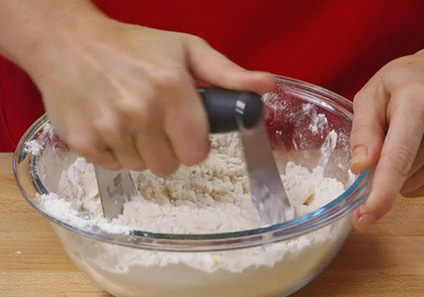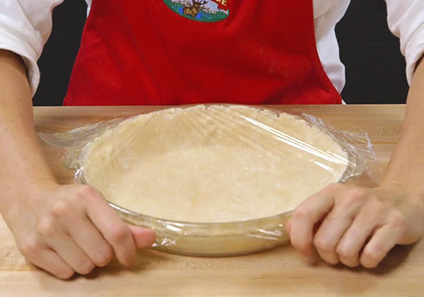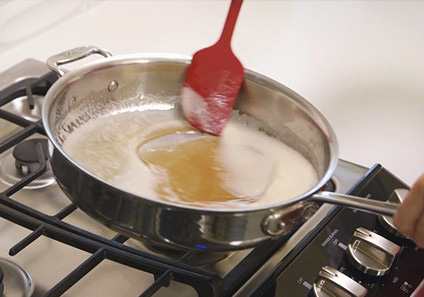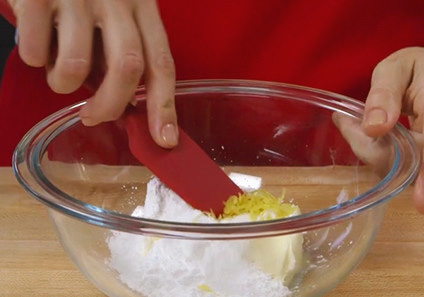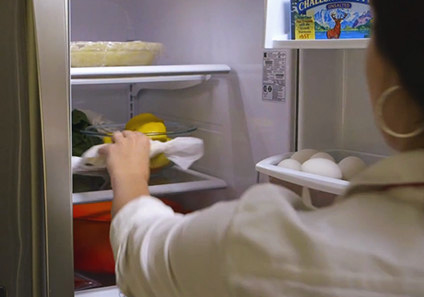General Guidelines
There are three main types of candies that contain butter: toffee, caramels, and fudge. The following guidelines apply to all:
-
1Avoid making candy on a humid day. The candy will absorb the moisture from the air when cooling and not set properly. If it is only slightly humid, cooking the candy a degree or two higher than directed may counteract this.
-
2Use a heavy saucepan (anodized aluminum, cast aluminum or cast iron). Butter the sides to keep sugar crystals from forming. If the recipe calls for melting the butter first, coat the sides of the pan before adding sugar. The saucepan should be an appropriate size for the recipe and match the size of the burner or be slightly undersized to minimize heat fluctuations in the candy.
-
3Use a candy thermometer that you have tested for accuracy in boiling water: It should read 212°F — if the thermometer reads higher or lower, add or subtract the difference from the recipe temperature.
-
4Do not attempt to rush the candy making process. Keep the temperature under the pan constant – set the burner temperature at medium and leave it — temperature fluctuations can lead to problems with sugar crystallization and fat separation in Toffee.
-
5After the sugar has dissolved and the mixture comes to a boil, cover the pan for 2 minutes to allow the steam to wash the sides. (This is to prevent crystals from forming on the sides of the pan.) Then uncover and stir the mixture as little as possible during the final cooking stages.
-
6Let the finished candy cool at room temperature. Do not try to hurry the process by putting the candy in the refrigerator or freezer.
Tips for Making Toffee
Toffee’s (English toffee or butter toffee) primary ingredient is butter. The most common difficulty in making toffee is butter separation. Here are some things you can do to prevent separation:
-
1Use salted butter. Salt seems to stabilize the mixture. If you use unsalted butter, add ¼ teaspoon of salt per stick of butter in the recipe.
-
2Melt the butter over medium heat and keep the temperature under the pot constant so the candy mixture is heated gradually.
-
3Remember to stir slowly and gently during the final stages of cooking.
What to do if separation occurs:
-
1Keep stirring and the candy may come back together on its own.
-
2Add hot water (a tablespoon at a time) — do not add more than a total ¼ cup (4 tablespoons) to recipe calling for 1 cup (2 sticks) of butter. Add water slowly and carefully as the water can cause the hot candy mixture to splatter. Stir and heat candy to the finished temperature.
Tips for Making Caramels
Caramels are the butter candy most sensitive to humidity. Most caramel recipes require a long cook time, typically 2-2½ hours, because of the amount of liquid that must be evaporated. Our recipes use sweetened condensed milk to reduce the cooking time to only 30-45 minutes.
Tips for Making Fudge
Graininess is the most common problem that occurs when making traditional fudge, but preparing traditional fudge is not difficult if you understand what needs to happen to create “melt-on-your-tongue” smooth candy. In making fudge, large uneven crystals of granulated sugar are dissolved and heated, then re-crystallized. The goal is to make sure the crystals that form are extremely small. Smaller crystals result in a smoother, creamier consistency in the finished fudge. Coarse grainy fudge results when large crystals are allowed to form.
-
1Butter is added in the final stages to add flavor and smoothness and inhibit large crystal formation. Use unsalted butter so you can add a small amount of salt (¼ teaspoon per stick of butter) to the sugar/liquid mixture. Salt tends to stabilize the mixture and keep it from foaming as much.
-
2The secret to perfect fudge is to stir as little as possible from the time the sugar is completely dissolved through cooking and cooling stages. Stirring and jarring of the sugar mixture, particularly during the cooling phase, can trigger sugar crystal formulation and result in coarse, grainy candy. Do not try to hasten the cooling process; sudden temperature changes can also lead to larger crystal formation.

